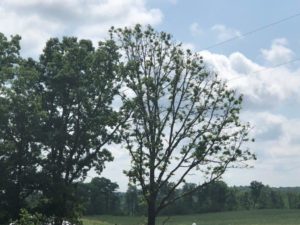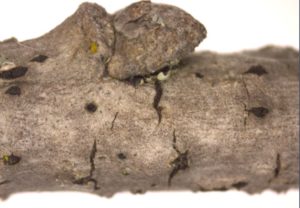by Paul Cigan, forest health specialist, Hayward, Paul.Cigan@wisconsin.gov. 715-416-4920 and Todd Lanigan, forest health specialist, Eau Claire, Todd.Lanigan@wisconsin.gov, 715-210-0150
Widespread dieback of twigs and branches and delayed leaf-out were present on bur oak trees this spring in Barron, Burnett, Chippewa, Eau Claire Polk, Rusk, and Sawyer counties, and in parts of central and east central Minnesota. Crown dieback of between 10 – 50% was observed in both mature and sapling-sized trees, although it was more common on open-grown trees and those along woodland edges. Tufted or “broomed” leaf shoots were apparent, a result of epicormic shoots developing below dead twigs and branches. Most impacted trees recovered well by early July as crowns filled in with leaves and epicormic shoots. Leaves in recovered trees appeared generally healthy and normal-sized.
A combination of gall wasp attacks followed by infection from twig blight pathogens may account for how widespread the problem has become. The presence of cynipid gall wasps is likely a major factor – larvae, gall chambers hidden inside the twigs, and exit holes were all common on dead twigs. Secondary infections by fungal pathogens such as Botryosphaeria and Diplodia spp. are suspected; fungal fruiting bodies characteristic of Botryosphaeria were frequently observed on twigs. Fungal activity was increased by unusually wet weather in 2017.
Landowners with affected trees are encouraged to be patient and facilitate recovery of their bur oak trees by providing adequate water, avoiding soil disturbance and compaction, and, when possible, controlling other pests and diseases.





